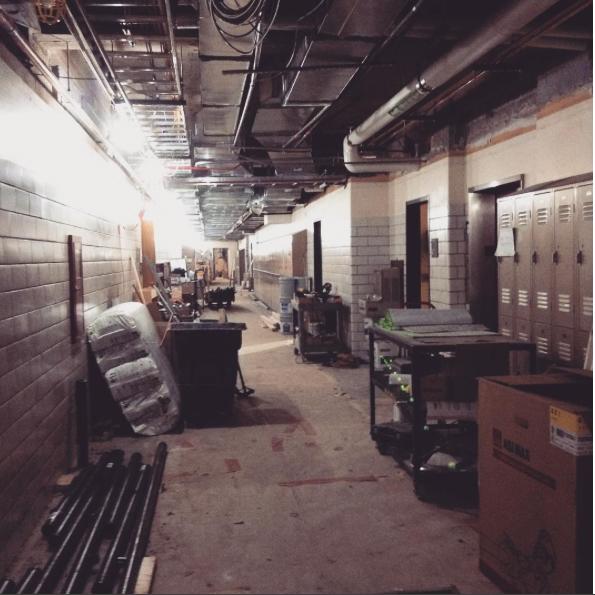Shoe prints are made in the dust on the floor. New paint smell collides with the smell of walls that just had their tiles taken off. Lights hang topsy-turvy from the ceilings. Classrooms have a single square where an old chalkboard used to be, and men with hard hats are around any and every corner while today’s hits radio plays Ariana Grande over the sound of jack hammers.
This is Cina Hall now, with construction that began in July, 2015.
Cina Hall, last updated in 1958, used to be one of the heaviest trafficked areas at UMD. The hall and staircases would be filled with students trying to get from one end of campus to the other. There were study areas packed with people and walls filled with paintings and sculptures. It housed the Geology department, Journalism, Anthropology and American Indian Studies Departments, to name a few.
Cina is undergoing a serious update. Classrooms, bathrooms, ventilation, heating, fire alarms, water systems and the hallways themselves are getting redone and replaced.
Before they could start the dirty work for the project, five weeks had to be taken from the calendar to move 72 people out of the hall and placed all around campus. Five semi-trailers full of furniture are currently in storage awaiting their return.
After the moving process, no time was wasted. The crew immediately got started working on the much needed renovations.
The heating system in the building used to be “old fashioned” steam heat according to John Kessler, UMD’s Project Manager. Now the building will have hot water heat like the rest of the buildings. “We’re moving towards that on campus,” says Kessler.
Old classrooms have been cleared to make room for brand new ventilation systems. “It helps filter and provide air,” Kessler says. “Sitting in the classroom you won’t get hot and sweaty.” The fresh, outside air will be heated or cooled (depending on the season) and travel to each classroom through ducts in the ceilings.
“There wasn’t one before so you had the stuffiness and no ventilation,” Kessler said. “Now we have the mechanical ventilation, which is what each building needs to have. After Cina there’s three buildings left to do on campus.”
Other necessary changes are the large, heavy doors. Each door is being replaced with fire doors which, when shut, will be able to hold a fire in for two hours. “They allow people a fighting chance to get out of a space,” says Kessler.
But it’s not just the entire systematic structure that is being redone, the classrooms and offices are receiving quite the makeover as well.
One change being made to every classroom and office in the building is the paint. Each room will have the same color scheme that was picked by the American Indian Studies Department and the Building Committee. They will have an orange accent wall on the lakeside of the room, representing the sun rising over the lake. While a brown beige balances the rest of the room.
Some areas, like the Sociology and Anthropology departments are already gifted with the bright new paint job.
After the paint is complete, new whiteboards and screen projectors will complete the classrooms.
The study areas, or “nooks and crannies” as Kessler calls them, will be back as well. The first floor of Cina, which was also the main hallway from the Kirby Student Center had a portion of the walls knocked out to make room for even more study and lounge spaces, looking out into the Tweed Sculpture Garden.
The money for the $4.6 million renovation came from HEAPR funds, which stands for Higher Education Asset Preservation and Renovation. Additional funding was also provided by Facilities Management, the College of Liberal Arts and campus reservations.
The new and improved building should be ready for use in July 2016 and ready to go for fall semester. Kessler says this schedule is what they were aiming for and they are on track.
